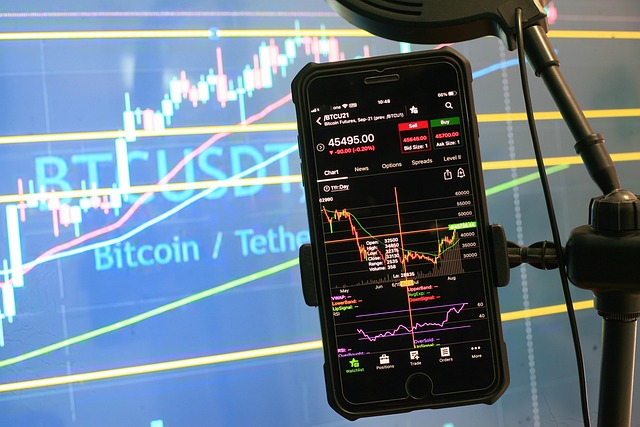Crypto Trading Bots Explained 2025 Guide
Author: Jameson Richman Expert
Published On: 2025-11-03
Prepared by Jameson Richman and our team of experts with over a decade of experience in cryptocurrency and digital asset analysis. Learn more about us.
Crypto trading bots explained — this article breaks down what crypto trading bots are, how they work, which strategies they use, and how to build, test, and deploy them safely in 2025. Whether you're a trader exploring automation, a developer building an algorithm, or a curious investor, you'll find practical steps, real examples, security best practices, legal considerations, and links to trusted resources to help you make smarter decisions.

Contents
- What are crypto trading bots?
- How crypto trading bots work
- Common bot strategies
- Types of bots and use cases
- Build vs. buy: choosing the right path
- Technical components and integration
- Backtesting, optimization, and pitfalls
- Deployment, monitoring, and fail-safes
- Risks, regulation, and taxes
- Real-world examples and simple strategy math
- Security best practices
- Checklist before going live
- Further learning and trusted resources
What are crypto trading bots?
Crypto trading bots are software programs that automatically place trades on behalf of users according to pre-defined rules or algorithmic strategies. These bots interact with cryptocurrency exchanges using APIs (Application Programming Interfaces) to read market data and submit orders without human intervention. In many cases they can execute trades far faster and more consistently than a human trader.
Algorithmic trading has a long history in traditional finance — see Algorithmic trading on Wikipedia — and the same principles have been adapted to cryptocurrency markets. For a primer on cryptocurrencies themselves, consult the Cryptocurrency page.
How crypto trading bots work
At a high level, bot operation follows a simple loop:
- Connect to exchange API and authenticate.
- Fetch market data (order book, trades, candlesticks).
- Run strategy logic (indicators, signals, models).
- Decide on orders (market/limit, size, price).
- Place orders and monitor fills.
- Handle risk management (stops, position sizing).
- Log activity and send alerts.
Technical details that matter in practice include API rate limits, WebSocket streams for real-time data, network latency, and how the bot handles partial fills, nonce errors, or exchange maintenance periods.

Common bot strategies
Different strategies suit different market structures and risk tolerances. Below are the most popular:
1. Trend following
These bots enter positions in the direction of the trend using indicators like moving averages, MACD, or ADX. They perform well in sustained directional markets but can suffer during choppy price action.
2. Mean reversion
Mean reversion bots assume price will revert to an average after an extreme move. They use Bollinger Bands or RSI to identify overbought/oversold conditions. Works best in range-bound markets.
3. Grid trading
Grid bots place buy/sell limit orders at fixed intervals above and below a price level, profiting from natural volatility without predicting direction. They are widely used for stablecoins/volatile pairs alike.
4. Market making
Market-making bots constantly post buy and sell limit orders to capture the spread while providing liquidity. This strategy requires control of inventory risk and attention to fees and adverse selection.
5. Arbitrage
Arbitrage bots exploit price differences across exchanges or between a spot market and derivatives. Cross-exchange arbitrage needs fast execution and sufficient capital on multiple platforms to avoid slippage and transfer delays.
6. Scalping
Scalping bots aim to take many small profits from small price movements. They prioritize execution speed and tight risk controls. Transaction costs and latency are critical.
7. AI / ML-driven strategies
Machine learning models (supervised learning, reinforcement learning) are increasingly used for signal generation and execution decisions. If you're interested in this frontier, read more in this guide on AI crypto and how it works.
Types of bots and practical use cases
- Cloud-hosted bots: Paid SaaS platforms that run bots for you (easier to set up, less maintenance).
- Self-hosted bots: Open-source or commercial software you run on your server or VPS (more control, requires ops skills).
- Exchange-native bots: Some exchanges offer built-in bots or strategies you can activate directly.
- Custom bots: Tailored strategies you develop or commission for proprietary needs.
If you prefer to build yourself, this practical guide to build your own crypto trading bot is a helpful step-by-step resource.
Build vs. buy: choosing your approach
Decision factors:
- Skillset: Do you know Python, Node.js, or another language and understand order execution?
- Control: Do you need custom logic, or will a prebuilt bot suffice?
- Cost: SaaS fees vs. development & hosting costs.
- Security: Are you comfortable storing API keys and managing infrastructure?
Many traders start with a reputable SaaS bot to learn conceptually, then migrate to a custom bot once they understand the constraints and requirements.

Technical components and integration
Core components every bot needs:
- Exchange API connectivity: REST for balancing and orders; WebSocket for real-time order books and trades. Read your exchange's API docs to respect rate limits.
- Data ingestion and storage: Historical candles, tick data, and order book snapshots for backtesting and live decisions.
- Strategy engine: Indicator calculations, decision tree, or ML inference layer.
- Order manager: Handles order types, retries, cancellations, and position tracking.
- Risk module: Position sizing, stop-loss rules, exposure limits, and max daily drawdown stop.
- Monitoring & alerting: Logging, dashboards, email/SMS/Telegram alerts for errors or risk breaches.
Exchanges commonly used by bot traders include Binance (register here), MEXC (register here), Bitget (register here), and Bybit (register here). Each platform has different fee structures, API designs, and risk controls — factor that into your architecture.
Backtesting, optimization, and common pitfalls
Backtesting is the most essential step before live deployment. Follow these best practices:
- Use high-quality historical data: Candle data alone is sometimes insufficient; include tick and order book snapshots for realistic slippage simulation.
- Simulate fees and slippage: Include maker/taker fees, funding rates for perpetuals, and realistic market impact.
- Out-of-sample testing: Split data into training and validation periods to reduce overfitting.
- Walk-forward analysis: Re-optimize periodically and test forward to mimic deployment reality.
- Paper trading: Run the bot in a dry-run mode on live data before risking real funds.
Common backtesting errors include look-ahead bias, survivorship bias (only testing top-ranked coins), and ignoring exchange-specific behaviors (rate limits, maintenance windows). Reading about modeling and bias on sites such as Investopedia helps understand these pitfalls.
Deployment, monitoring and fail-safes
When you move to live trading, you need robust operational procedures:
- Staging environment: Use a testnet where available (e.g., Binance testnet) or paper trading before live orders.
- Auto-suspend rules: Pause trading on major drawdowns, exchange errors, or connectivity loss.
- Alerts and observability: Use logging, dashboards, and alerts to detect anomalies fast. Telegram or SMS alerts are common; see this Telegram signals guide 2025 for practical alerting tips.
- Redundancy: Consider multi-region VPS, database replication, and hot-backups for low-latency failover.

Risks, regulation and taxes
Automated trading introduces operational, market, and regulatory risk:
- Market risk: Bots can compound losses quickly during extreme volatility.
- Counterparty risk: Exchange insolvency, hacking, or withdrawal freezes can trap funds.
- Legal/regulatory risk: Some jurisdictions restrict certain automated strategies or classify certain operations as market manipulation. Always check local laws and the terms of service of each exchange. Official resources include the U.S. Securities and Exchange Commission and local financial regulators.
- Taxes: Crypto trading is taxable in many jurisdictions. For U.S. residents, the IRS FAQ on virtual currency transactions is a starting point. Consult a tax professional for accurate reporting.
Real-world examples and simple strategy math
Example 1 — Simple grid bot (USD/BTC):
- Current BTC price: $50,000
- Grid levels: every $1,000 from $48,000 to $52,000 (5 buy levels, 5 sell levels)
- Order size: 0.01 BTC per level
- If price oscillates between $48k and $52k and the bot completes 10 round trips at an average spread of $500, gross profit = 10 * 0.01 * $500 = $50. Fees and funding reduce profits; grid is profitable if volatility exists without a strong trend.
Example 2 — Cross-exchange arbitrage between Exchange A and B:
- BTC on Exchange A: $50,000; on Exchange B: $50,300.
- Arbitrage opportunity: $300 spread. After fees and transfer costs suppose net spread = $200. If you have 0.5 BTC on both exchanges and can instantly trade, profit per arbitrage = 0.5 * $200 = $100. But real-world limits—withdrawal time, transfer fees, and slippage—often eliminate easy arbitrage; this is why many traders maintain balances on multiple exchanges.
For more signal-oriented approaches and free Bitcoin signal education, see this Bitcoin signals free guide.
AI and the future of crypto trading bots
AI and ML are increasingly used to generate signals, cluster regimes, and optimize execution. However, ML models require careful feature engineering, high-quality data, and continuous monitoring for concept drift. Read a comprehensive view of AI in crypto here: What is AI crypto — comprehensive guide.
Limitations of AI in trading:
- Overfitting to historical quirks.
- Black-box decisions that are hard to audit.
- Sensitivity to regime changes and liquidity shocks.

Signals, social proof and Telegram groups
Many traders supplement bots with signals from Telegram groups or services. Signals can be useful but require validation and risk controls. If you use signals, integrate them conservatively into a rules-based bot and avoid blindly following them. For safe adoption of social signals, see this practical Telegram signals guide 2025.
Comparing Bitcoin and Ethereum trading for bots
Bitcoin and Ethereum differ in volatility, liquidity, and macro correlations. If you want to learn the practical differences and how they affect trading strategies, this article provides a clear comparison: Difference between Bitcoin and Ethereum. Key points:
- ETH often exhibits higher intraday volatility due to network events, DeFi activity, and token listings.
- ETH has different derivatives dynamics (e.g., staking, liquidation cascades) impacting funding rates.
- Choose pairs and risk parameters to reflect these differences.
Choosing exchanges and providers
When selecting an exchange for your bot, consider:
- Liquidity: High liquidity reduces slippage for market orders.
- Fees: Maker/taker fees influence profitability, especially for market-making and scalping strategies.
- API quality: Stable, low-latency APIs with good documentation reduce operational risk.
- Security and reputation: Look at track record and security incidents.
- Available instruments: Spot, futures, options, and leverage levels matter for strategy choice.
Some recommended exchanges for bot traders include:
- Binance — large liquidity and variety of instruments (register here).
- MEXC — competitive fees and altcoin listings (register here).
- Bitget — derivatives-focused with copy-trading features (register here).
- Bybit — strong derivatives trading APIs and liquidity (register here).

Security best practices
Protect your funds and credentials by following strict security hygiene:
- API key permissions: Give the minimum necessary permissions. For trading bots, allow trading but disable withdrawals.
- IP whitelisting: Restrict API keys to trusted server IPs where possible.
- Store secrets securely: Use environment variables, secret managers (e.g., AWS Secrets Manager), or encrypted vaults.
- 2FA and account protection: Enable two-factor authentication and use strong password managers.
- Audit logging: Keep immutable logs and monitor unrecognized activity.
Common mistakes to avoid
- Deploying with unrealistic backtest assumptions (no slippage or fees).
- Using poor-quality data or ignoring exchange-specific quirks.
- Running bots 24/7 without monitoring or automated shutdown rules.
- Exposing API keys or enabling withdrawals on bot accounts.
- Over-leveraging; leverage magnifies both returns and losses.
Checklist before going live
- Complete robust backtesting with out-of-sample and walk-forward tests.
- Paper trade for several market conditions (bull, bear, sideways).
- Implement and test fail-safes and auto-suspend logic.
- Secure API keys and restrict permissions.
- Set monitoring, alerts, and a clear escalation path for issues.
- Confirm tax and legal implications in your jurisdiction.

Further learning and trusted resources
To continue learning:
- Practical builds: follow the step-by-step guide to build your own crypto trading bot.
- Signals & community: learn safe signal integration via the Telegram signals guide.
- Market education: compare asset behavior with the Bitcoin vs Ethereum guide.
- Free signals and opportunities overview: Bitcoin signals free guide.
- Deep dives into AI: see the article on AI crypto for advanced signal concepts.
- Regulatory guidance: check the U.S. SEC and your local financial regulator pages for compliance updates.
Conclusion
Crypto trading bots can amplify a trader’s edge by automating disciplined execution, managing orders faster than a human, and exploiting opportunities 24/7. However, success depends on realistic backtesting, robust risk controls, secure architecture, and ongoing monitoring. Whether you use a cloud bot, customize an open-source system, or build your own, follow the checklist above, start small, and scale responsibly.
For step-by-step help building a bot or integrating signals, check the practical guides and signal resources linked above. Combining rigorous testing with strong security and conservative position sizing will give you the best chance to harness automation safely in 2025 and beyond.